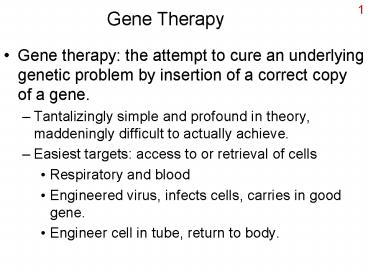Gene Therapy - PowerPoint PPT Presentation
Title:
Gene Therapy
Description:
Gene Therapy Gene therapy: the attempt to cure an underlying genetic problem by insertion of a correct copy of a gene. Tantalizingly simple and profound in theory ... – PowerPoint PPT presentation
Number of Views:64
Avg rating:3.0/5.0
Title: Gene Therapy
1
Gene Therapy
- Gene therapy the attempt to cure an underlying
genetic problem by insertion of a correct copy of
a gene. - Tantalizingly simple and profound in theory,
maddeningly difficult to actually achieve. - Easiest targets access to or retrieval of cells
- Respiratory and blood
- Engineered virus, infects cells, carries in good
gene. - Engineer cell in tube, return to body.
2
Recent successes
- Adenosine Deaminase deficiency
- Defect in nucleoside metabolism especially
affects white blood cells - X-linked chronic granulomatous disease
- Neutrophils fail to make superoxide
- General scheme Retrovirus used to replace gene
in bone marrow cells, return cells to patient
3
Failures
- Genes dont always make into genome
- cure is short-lived as DNA disappears
- Viruses carrying genes insert in bad places
- Cause over-expression of genes or DNA deletions
- Cancer
- Immune system becomes sensitized to vector
- Death of patient in clinical trial in 1999.
4
New development
- Sleeping Beauty transposon system
- First transposon available in vertebrates?
- Originally from inactive fish transposon
- Engineer with gene of interest
- Transposon inserts with gene, getting it into the
chromosome - Inserts in different places from viral vector
- Much higher rate of gene insertion
5
Sleeping Beauty Transposon system
Active transposon engineered from an inactive
fish transposon. Transposon jumps into chromosome
bringing good gene with it.
http//www.discoverygenomics.net/sbts.html
6
DNA Polymorphisms DNA markers a useful tool in
biotechnology
- Any section of DNA that varies among individuals
in a population, many forms. - Examples include SNPs, RFLPs, STRPs, and AFLPs
- RFLPs include VNTRs and STRPs
- microsatellites (STRs) SSLPs STRPs SSRs
- Useful for finding, mapping genes involved in
disease, and - Individual identification, epidemiology,
anthropology, population/ecology studies,
taxonomy.
7
SNPs
Single nucleotide polymorphisms regions of DNA
where one base pair is different. Occur evenly
spread over all the DNA. 1/ 1000-3000
bp Detected by sequencing. If SNP occurs in a
restriction enzyme site, it generates an
RFLP. Could be in coding or non-coding
regions. Over 300,000 human SNPs known and are
being mapped.
8
SNP
9
RFLPs
Restriction fragment length polymorphism. Mutation
at a restriction site prevents recognition
cutting. Results in one band of larger DNA
instead of 2 smaller ones.
scidiv.bcc.ctc.edu/.../lectures/
DNATechnology/image021.jpg
10
Other RFLPs VNTRs and STRPsMinisatellites and
Microsatellites
- These are RFLPs because they are defined by or
visible following restriction enzyme cuts. - Variable Number Tandem Repeats
- Groups (10-100) of nucleotides repeated 2 100
times (depending on individual and locus). - Restriction sites on both sides of repeated DNA
- The more repeats, the longer the fragment.
- Simple Tandem Repeat Polymorphisms
- Shorter, 2-9 nucleotides repeated
- Small enough number for PCR amplification
- Also called STRs, SSLPs, etc.
11
Use of VNTRs
Restriction sites are on either side fragment
length depends on number of repeats in between
sites.
12
STRPs
Primers for both sides of repeated region allow
PCR amplification of DNA generates PCR products
that differ in length depending on number of
repeats. Becoming the standard method for DNA
testing in forensics labs. Cheaper, easier, more
sensitive.
13
STRs in forensics
- Locus vWA
- 14 0.081
- 15 0.107
- 15.2 0.179
- 16 0.306
- 17 0.192
- 18 0.089
- 19 0.047
Alleles in different ethnic and racial groups
examined, used as database. Panel of 13
different STRs are used. Because the odds of a
particular combination of the 13 is product of
the frequencies, numbers like 1 in 10 billion can
be generated.
Band frequency
14
THE 13 CODIS STRs
STR African-American U.S. Caucasian
D3S1358 0.102 0.078
vWA 0.058 0.065
FGA 0.035 0.036
TH01 0.102 0.094
TPOX 0.081 0.211
CSF1PO 0.070 0.122
D5S818 0.097 0.140
D13S317 0.131 0.074
D7S820 0.081 0.061
D8S1179 0.075 0.067
D21S11 0.033 0.045
D18S51 0.028 0.030
D16S539 0.066 0.103
http//expertpages.com/news/dna.htm
15
RAPD using PCR to find polymorphisms
- Random amplified polymorphic DNA
- Screen DNA from individuals by doing PCR with
random short primers. - By random chance, primers will amplify many
different sections of DNA. - Look for bands on gel that are not present in
each individual tested.
avery.rutgers.edu/.../ archives/onions/rapd.html
16
RAPD using PCR to find polymorphisms-2































